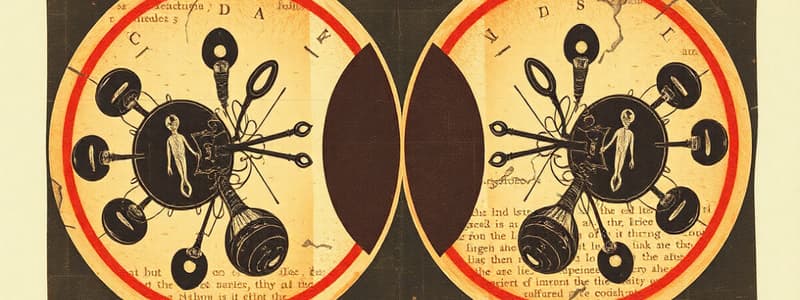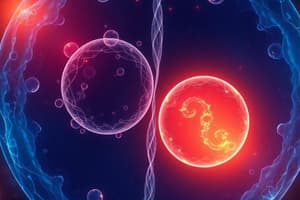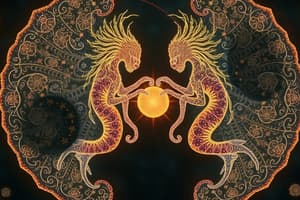Podcast
Questions and Answers
What major event occurs during prophase of mitosis?
What major event occurs during prophase of mitosis?
- Homologous chromosomes pair up and cross over.
- Chromatin begins to condense into visible chromosomes. (correct)
- Cytokinesis begins to occur.
- The nuclear envelope re-forms around the chromosomes.
Which structures are responsible for forming the mitotic spindles during prophase?
Which structures are responsible for forming the mitotic spindles during prophase?
- Centrifuges
- Centrosomes (correct)
- Nuclear envelope
- Chromatin fibers
What is the shape of chromosomes during prophase of mitosis?
What is the shape of chromosomes during prophase of mitosis?
- Spiral
- Linear
- X-shaped (correct)
- Circular
Why is DNA replication important before entering mitosis?
Why is DNA replication important before entering mitosis?
What happens to the nucleolus during prophase?
What happens to the nucleolus during prophase?
What occurs to the centriole positions during prophase?
What occurs to the centriole positions during prophase?
During which stage do homologous chromosomes cross over?
During which stage do homologous chromosomes cross over?
What is the main purpose of mitosis in an organism?
What is the main purpose of mitosis in an organism?
Which of the following statements is true regarding somatic cells?
Which of the following statements is true regarding somatic cells?
How many chromosomes do human gametes contain?
How many chromosomes do human gametes contain?
In which phase does the cell prepare for mitosis?
In which phase does the cell prepare for mitosis?
What distinguishes meiosis from mitosis in terms of cell division outcomes?
What distinguishes meiosis from mitosis in terms of cell division outcomes?
What is the result of fertilization between a sperm and an egg cell?
What is the result of fertilization between a sperm and an egg cell?
Which phase of meiosis immediately follows prophase I?
Which phase of meiosis immediately follows prophase I?
Which of these types of cells undergo meiosis?
Which of these types of cells undergo meiosis?
Flashcards are hidden until you start studying
Study Notes
Mitosis
- Mitosis is somatic cell division resulting in two identical daughter cells.
- Purpose: growth, development, and repair.
- Stages: prophase, metaphase, anaphase, telophase, and cytokinesis.
- Cytokinesis is the physical cell division, sometimes considered a separate stage.
Meiosis
- Meiosis is germ cell division creating four genetically different gametes (sex cells).
- Two rounds of division: Meiosis I and Meiosis II, each with prophase, metaphase, anaphase, and telophase stages.
- Gametes have half the chromosomes of the parent cell. Human gametes have 23 chromosomes.
- Fertilization combines gametes (23+23) to restore the full chromosome set (46).
Prophase
- The first phase of both mitosis and meiosis.
- Preceded by interphase (cell growth and DNA replication).
- Key events:
- Chromatin condensation into visible X-shaped chromosomes.
- Mitotic spindle formation (microtubules for chromosome movement).
- Nucleolus disappearance.
- Nuclear envelope disintegration.
- Centrosome migration to cell poles.
Prophase in Mitosis
- Chromatids (replicated DNA) are joined at the centromere.
- No chromosome pairs; each chromosome consists of two sister chromatids.
- Chromosome condensation allows separation during anaphase.
- Mitotic spindles attach to chromosomes via centrosomes at cell poles.
Prophase I in Meiosis
- Homologous chromosomes pair up and cross over (exchange genetic material).
- Crossing over creates genetic variation. This does not happen in mitosis or meiosis II.
- Chromosomes condense, become visible, and attach to spindle fibers from opposite poles.
- Homologous chromosome separation occurs in metaphase I.
Prophase II in Meiosis
- Chromosomes condense again; nuclear envelope breaks down.
- Centrosomes migrate to poles; spindle fibers form.
- Homologous chromosomes are already separated (from Meiosis I).
- Sister chromatid separation will occur in metaphase II.
Chromosomes and DNA
- Chromatin: uncondensed DNA and proteins.
- Chromosome: condensed chromatin.
- Centromere: the point where sister chromatids connect.
- Homologous chromosomes: matching chromosome pairs (one from each parent). They carry the same genes but may have different alleles.
Studying That Suits You
Use AI to generate personalized quizzes and flashcards to suit your learning preferences.





